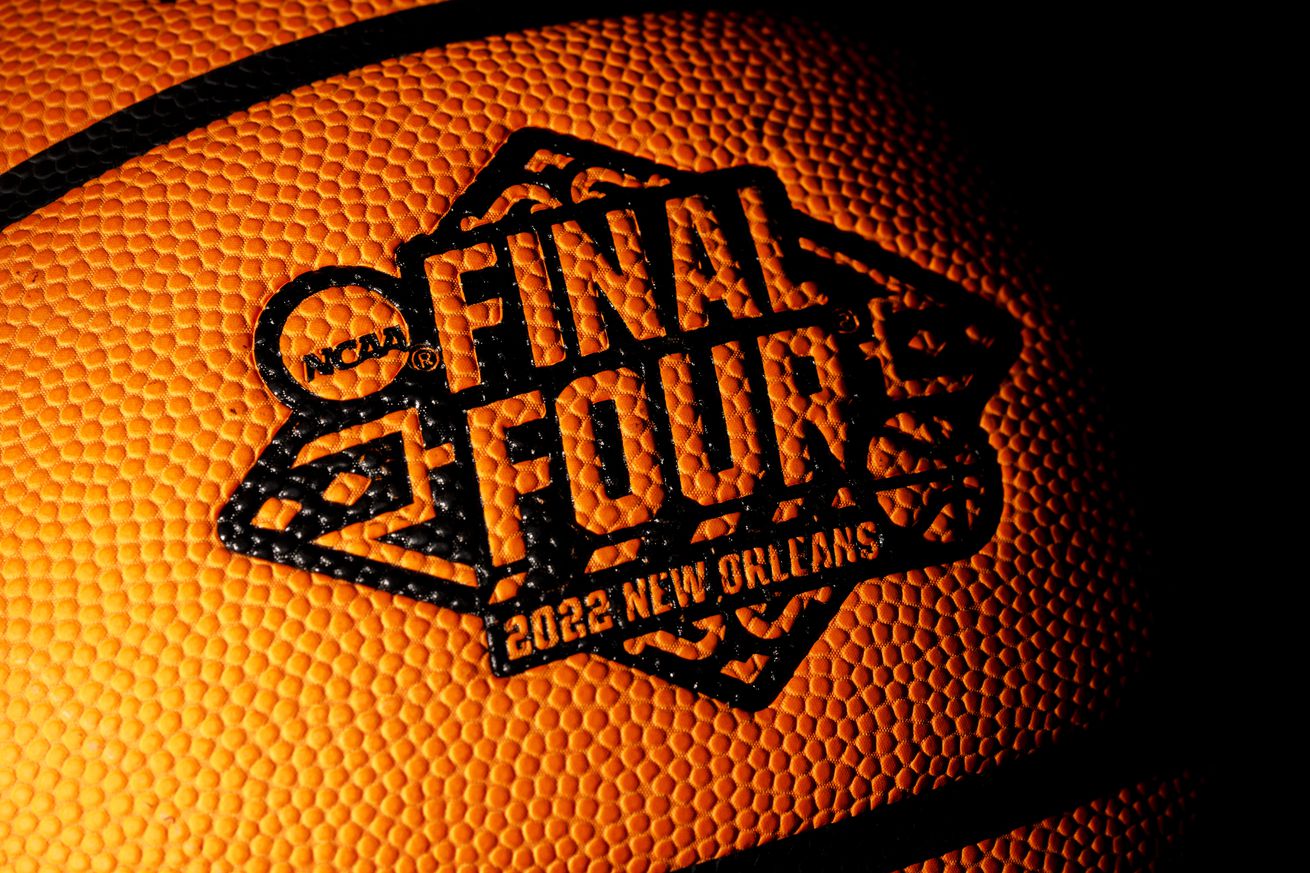
Looking at the impact of the transfer portal and “one and done” talent
Some Spartan squads are still in action this spring including baseball, men’s and women’s golf, and rowing but, of course, basketball is always of huge importance to Spartan fans even though it’s the offseason.
Transfers have become a huge part of the game and a major discussion point over the last several years. Tom Izzo has already added Trey Fort (Samford) and Kaleb Glenn (FAU) from the portal since the 2025 season came to a close and he may be looking to add one more to the mix.
In our best attempt to keep you engaged, TOC, during these slower football and basketball months, we tried to take a look at the impact of transfer players on Final Four teams.
Michigan State hasn’t made a Final Four since 2019 – just before the transfer portal started to have a major impact on college basketball rosters. Tom Izzo has also been criticized at times for not making better use of the portal. But how have MSU’s rosters compared to teams that have made a Final Four since the transfer portal (and the NIL that comes with it) took over the sport?
The goal of this project was to analyze the regular playing rotation of men’s basketball teams that competed in the 2021, 2022, 2023, 2024, and/or 2025 NCAA Final Fours and then compare those rosters to the rotation of the Michigan State teams from those same years.
Variables examined were the number of players in a team’s playing rotation, percentage of transfer and non-transfer players in the rotation, and prevalence of “one and done” players in the rotation. “One and done” players spend only one year in college and then declare for the NBA draft.
The NCAA adopted the transfer portal on October 15, 2018 – right before the start of the 2018-2019 college basketball season. Because of this timing, the new rule probably did not have an effect on the 2018-2019 basketball season or the teams playing in the 2019 Final Four.
The 2020 NCAA tournament was canceled due to the Coronavirus pandemic so there is no Final Four data from that year. As a result, the first year in which the transfer portal had an effect on the roster makeup of Final Four teams was in 2021.
This project attempts to narrow in on the regular playing rotation for each team rather than the entire roster. To determine regular playing rotation, data was taken from each team’s roster and statistics on espn.com . The rosters were sorted by number of games played and minutes played per game to try to determine who was in a team’s regular rotation.
Without going into a huge amount of boring detail here, it took a little bit of effort to sift through this. It might be best to just look at a familiar example – The 2025 MSU team.
These players were considered part of the regular rotation (with games played and minutes per game shown below):
Jaden Akins: 37, 27.2
Jase Richardson: 36, 25.3
Jeremy Fears Jr.: 36, 23.7
Tre Holloman: 37, 23.1
Jaxon Kohler: 37, 20.8
Coen Carr: 37, 20.7
Carson Cooper: 37, 17.1
Frankie Fidler: 37, 16.2
Szymon Zapala: 36, 14.2
Xavier Booker: 33, 12.8
Those not considered part of the regular rotation were:
Kur Teng: 19, 2.9
Gehrig Normand: 13, 2.0
Nick Sanders: 10, 1.4
For this MSU team, it may be worth debating Booker’s inclusion in the rotation. He played regularly with 33 appearances in 37 games. However, his role diminished as it got later in the season, especially in the NCAA tournament. Booker’s only action was three minutes of garbage time in a blowout opening round win over Bryant. He didn’t play at all in wins against New Mexico and Mississippi or the season-ending regional final loss to Auburn.
After some internal back and forth, Booker was included here because he was a part of the regular rotation that got MSU to the tournament. A similar analysis occurred for every team in this study and certainly there are arguments that could be made either way for players on many of these teams.
After the rotation was nailed down, the roster information on espn.com was used to determine a player’s year and transfer status. For example, 2025 was Coen Carr’s second year of experience in college basketball and he is a non-transfer. For Szymon Zapala, 2025 was his fifth year of college hoops and he was a two-time transfer. Note that, for this study, how many times a player transferred wasn’t considered – only if they had or had not transferred prior to the year in question. To hopefully drive the point home, Tre Holloman would be considered a three year non-transfer on the 2025 MSU team. Even though he has since transferred to North Carolina State, Holloman had only played at MSU through the 2025 season.
As far as “one and done” players, examples from MSU include Max Christie in 2022 and Jase Richardson this year. While players can still opt out of the NBA draft until June 15, Richardson hasn’t done so as of now and is considered a one and done player in this analysis.
So, without further delay, the charts below show the following conclusions:
Michigan State’s rotation is larger than the average Final Four team. MSU regularly plays about 10 guys while Final Four teams have a shorter bench with an average rotation between 8 and 9.
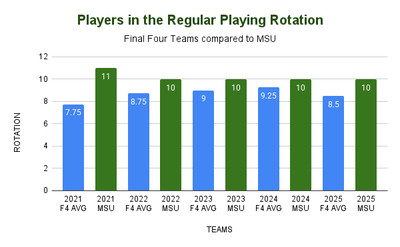
Michigan State’s rotation is younger/less experienced than the average Final Four team. Rotation players on Final Four teams are, on average, in their third year of college basketball while MSU’s rotation players average less than three years of experience.
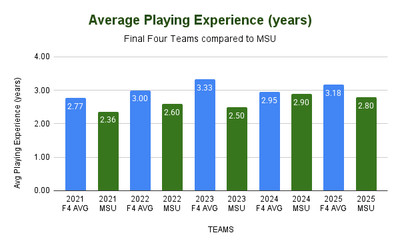
Unless you’re Duke, “one and done” players are not going to get you to a Final Four. The 2022 and 2025 Blue Devils’ teams each had three one and done players but no other Final Four team has had more than one. Most teams that make it to the Final Four don’t have any one and done players.
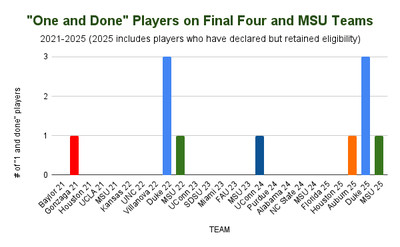
Final Four teams have about twice as many transfer players in their rotation as MSU.

And, over the last three years, Final Four teams have had four transfer players as part of their regular rotation.

Most transfers are joining their new team with a decent amount of experience. Teams that make it to a Final Four might be doing it with transfers that are in their first year with the team. However, these are generally more experienced guys. In other words, transfers on Final Four teams have spent more than one year in college prior to transferring to the Final Four team. Generally, they are not transferring after just one year in school and then finding themselves playing in a Final Four the next year.
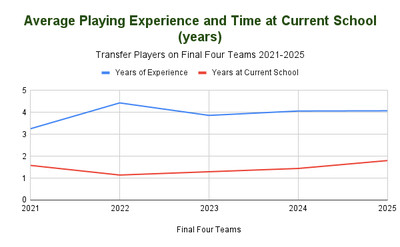
Of course, all of this only takes into account the prevalence of transfer players in a Final Four team’s rotation. It doesn’t look at the full impact, other than being a rotation player, that these transfers players had on their new team.
If there is any interest, we could try to look further at the role of the transfer players. Were they starters or did they come off the bench? Did they lead their team in scoring, minutes, rebounds, or some other statistical category?
For example, it’s interesting that MSU got within a game of the Final Four this year with Frankie Fidler and Szymon Zapala – a couple of solid players but perhaps not as impactful from a statistical standpoint as Tyson Walker or Joey Hauser – players on teams that didn’t get as close to a Final Four as this year’s Spartans. It might be interesting to see how many transfers are stars on their team vs. experienced “glue guys”.
Let us know what you think!
